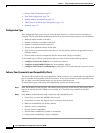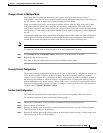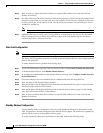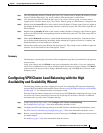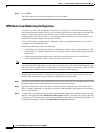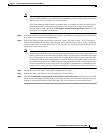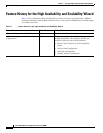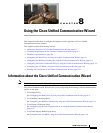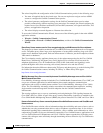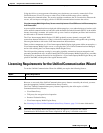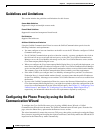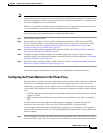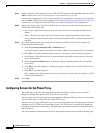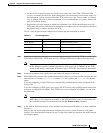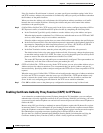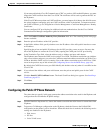
8-2
ASDM configuration guide
Chapter 8 Using the Cisco Unified Communication Wizard
Information about the Cisco Unified Communication Wizard
The wizard simplifies the configuration of the Unified Communications proxies in the following ways:
• You enter all required data in the wizard steps. You are not required to navigate various ASDM
screens to configure the Unified Communications proxies.
• The wizard generates configuration settings for the Unified Communications proxies where
possible, automatically, without requiring you to enter data. For example, the wizard configures the
required access lists, IP address translation (NAT and PAT) statements, self-signed certificates, TLS
proxies, and application inspection.
• The wizard displays network diagrams to illustrate data collection.
To access the Unified Communication Wizard, choose one of the following paths in the main ASDM
application window:
• Wizards > Unified Communication Wizard.
• Configuration > Firewall > Unified Communications, and then click Unified Communication
Wizard.
Phone Proxy: Secure remote access for Cisco encrypted endpoints, and VLAN traversal for Cisco softphones
The phone proxy feature enables termination of Cisco SRTP/TLS-encrypted endpoints for secure remote
access. The phone proxy allows large scale deployments of secure phones without a large scale VPN
remote access hardware deployment. End-user infrastructure is limited to just the IP endpoint, without
VPN tunnels or hardware.
The Cisco adaptive security appliance phone proxy is the replacement product for the Cisco Unified
Phone Proxy. Additionally, the phone proxy can be deployed for voice/data VLAN traversal for
softphone applications. Cisco IP Communicator (CIPC) traffic (both media and signaling) can be
proxied through the ASA, thus traversing calls securely between voice and data VLANs.
For information about the differences between the TLS proxy and phone proxy, go to the following URL
for Unified Communications content, including TLS Proxy vs. Phone Proxy white paper:
http://www.cisco.com/go/secureuc
Mobility Advantage Proxy: Secure connectivity between Cisco Mobility Advantage server and Cisco Unified
Mobile Communicator clients
Cisco Mobility Advantage solutions include the Cisco Unified Mobile Communicator (Cisco UMC), an
easy-to-use software application for mobile handsets that extends enterprise communications
applications and services to mobile phones and the Cisco Unified Mobility Advantage (Cisco UMA)
server. The Cisco Mobility Advantage solution streamlines the communication experience, enabling
single number reach and integration of mobile endpoints into the Unified Communications
infrastructure.
The security appliance acts as a proxy, terminating and reoriginating the TLS signaling between the
Cisco UMC and Cisco UMA. As part of the proxy security functionality, inspection is enabled for the
Cisco UMA Mobile Multiplexing Protocol (MMP), the protocol between Cisco UMC and Cisco UMA.
Presence Federation Proxy: Secure connectivity between Cisco Unified Presence servers and Cisco/Microsoft
Presence servers
Cisco Unified Presence solution collects information about the availability and status of users, such as
whether they are using communication devices, such as IP phones at particular times. It also collects
information regarding their communications capabilities, such as whether web collaboration or video
conferencing is enabled. Using user information captured by Cisco Unified Presence, applications such
as Cisco Unified Personal Communicator and Cisco UCM can improve productivity by helping users
connect with colleagues more efficiently through determining the most effective way for collaborative
communication.



